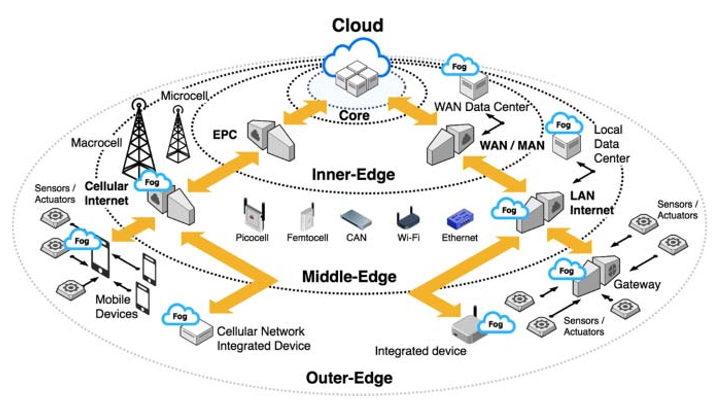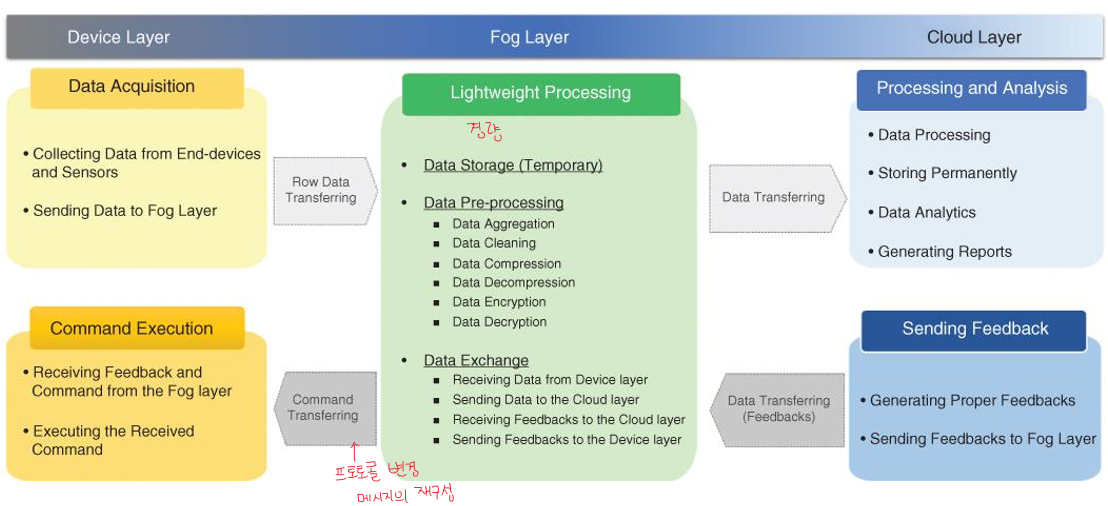2 min to read
Edge computing notation & summary
Edge computing notation & sumary

ReadMe
아래 내용은 Rajkumar Buyya, Satish Narayana Srirama 저서인 For and Edge Computing: Principles and Paradigms 책의 내용을 주로 다루고 있습니다.
Information
IoT: Internet of Things
CIoT: Cloud-centric Internet of Things
FEC: Fog and Edge Computing
ETSI: European Telecommunications Standards Institute
MEC: Multi-access Edge Computing
Cloudlet: 클라우드의 분할된 형태(가상머신)
NFV: Network Function Virtualization
BTS: Base Transceiver Stations
Mist computing: Fog보다 디바이스에 가깝게 구성된 기법
CE: Containers Engine
ODP: On-demand Data Processing-
SDN: Software-Defined Network
QoS: Quality of Service
Network slice: 물리적인 네트워크를 소프트웨어로 가상분할 하는 것
C2T: Cloud to Thing
BBU: Base Band Unit
NAT: Network Address Translation
SFC: Service Function Chains
CRAN: Cloud Radio Access Network
FRAN: Fog Radio Access Netowrk
5G: 30~300 Ghz 대역
Components
CIoT의 도전과제
BLURS: Bandwidth, Latency, Uninterrupted, Resource-constraint, Security
FEC(Fog and Edge Computing)의 장점
SCALE: Security, Cognition, Agility, Latency, Efficiency
FEC 장점을 달성하기 위한 요소
SCANC: Storage, Compute, Acceleration, Networking, Control
Management 도전과제
Discovery of edge nodes, Deployment of service and applications, Migrating services, Load balacing
Resource management 도전과제
Benchmarking, Provisioning, Discovery, Scaling, Migration
Networking 도전과제
User mobility, QoS in a dynamic environment, Achieving a service-centric model, Ensuring reliability and service mobility, Managing multiple administrative domains
융합된 C2F2T 성능
Energy consumption, Performance, Resource consumption, Costs, QoS, Security
Resource Usage
CPU usage, Memory, Netowrk bandwidth
Optimization 종류
data-related optimization, code-related optimization, task-related optimization
design-time optimization, deployment-time optimization, run-time optimization
포그시스템에서 Data management의 장점
Increasing efficiency, Increasing the level of privacy, Increasing data quality, Decreasing the end-toend latency, Increasing dependability, Decreasing cost
Fog data 라이프 사이클
Data acquisition, Lightweight Processing, Processing and Analysis, Sending Feedback, Command Execution
Data 특징들
Heterogeneity, Inaccuracy, Weak semantics, Velocity, Redundancy, Scalability, Inconsistency
데이터 전처리와 분석들
Data Cleaning(Declarative data cleaning, Model-based data cleaning), Data Fusion, Edge Mining
레이어별 아키텍쳐 구조의 내용
- Device Layer = {Registration, Data Collection / Command Execution}
- Fog Layer = {Resource Management, Temporary Storage, Authentication, Interpretation and Conversion, Pre-Processing, Encryption / Decryption, Compression / Decompression}
- Cloud Layer = {Permanent Storage, Global Decision-Making, Encryption / Decryption, Compression / Decompression, Data Analysis}
Services
Iaas: Infrastructure as a service
PaaS: Platform as a service
SaaS: Software as a service
CaaS: Context as a service (Containers as a service도 있음)
XaaS: Anything as a service
EaaS: Edge as a service
NaaS: Network as a service
Networking
Virtical networking: TCP/UDP, HTTP, IETE, CoAP, XMPP, AMQP, MQTT
Horizontal networking: Bluetooth, ZigBee, Z-Wave
Notation
\[c: \text{cloud}\\ E: \text{set of edge resources}\\ D^e: \text{set of end devices connected to edge resources }e\in E\\ R: \text{set of all resources}\\ a(r): \text{compute capacity of resource } r \in R\\ s(r): \text{compute speed of resource }r \in R\\ w(r): \text{marginal energy consumption of resource }r \in R\\ L: \text{set of all links between resources}\\ t(l): \text{latency of link } l \in L\\ b(l): \text{bandwidth of link } l \in L\\ w(l): \text{marginal energy consumption of link } l \in L\]Figures





Comments